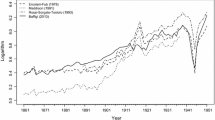Abstract
In this chapter I discuss the period in America from 1900 to 1965. Data for a number of variables can be found as far back as 1900 and some data go back even farther. Other data, industrial production indices and the rate of profit, do not go back so far. However, the data that do exist will help solidify one’s understanding of the business cycle. This chapter completes my historical analysis of the business cycle and provides further empirical evidence of the validity of Austrian Business Cycle Theory (ABCT). During this period, according to real gross national product (GNP), recessions or depressions occurred in 1904, 1908, 1914–15, during the post-World War I (WWI) period, 1924, 1927, 1930–33, 1938, toward the end of and immediately after World War II (WWII), 1954, and 1958.
Access this chapter
Tax calculation will be finalised at checkout
Purchases are for personal use only
Preview
Unable to display preview. Download preview PDF.
Similar content being viewed by others
Notes
Benjamin M. Anderson, Economics and the Public Welfare: A Financial and Economic History of the United States, 1914–46 (Indianapolis, IN: Liberty Press 1979 [1949]), pp. 92–93 and 349–352.
C. A. Phillips, T. F. McManus, and R. W. Nelson, Banking and the Business Cycle (New York: The Macmillan Co., 1937), p. 127.
Jay Cochran III, “Of Contracts and the Katallaxy: Measuring the Extent of the Market, 1919–1939,” The Review of Austrian Economics vol. 17, no. 4 (2004), pp. 407–466. See in particular pp. 427–429 for the data on which this value is based.
I discuss in great detail many of the regulations used by the government—pre- and post-Fed creation—to exert influence over the monetary and banking system and the effects these controls had (and still have today) in Chapters 4 and 7 of Brian P. Simpson, Money, Banking, and the Business Cycle, Volume 2: Remedies and Alternative Theories (New York: Palgrave Macmillan, 2014).
My discussion on WWII, the Great Depression, and prosperity is based on George Reisman, Capitalism: A Treatise on Economics (Ottawa, IL: Jameson Books, 1996), pp. 262 and 592–594. Also see
Ludwig von Mises, Nation, State, and Economy, translated by Leland B. Yeager (Menlo Park, CA: Institute for Humane Studies, 1983), pp. 183–197 and
Robert Higgs, “Wartime Prosperity? A Reassessment of the U.S. Economy in the 1940s,” The Journal of Economic History vol. 52, no. 1 (March 1992), pp. 41–60.
Copyright information
© 2014 Brian P. Simpson
About this chapter
Cite this chapter
Simpson, B.P. (2014). The Business Cycle in America from 1900 to 1965. In: Money, Banking, and the Business Cycle. Palgrave Macmillan, New York. https://doi.org/10.1057/9781137331496_10
Download citation
DOI: https://doi.org/10.1057/9781137331496_10
Publisher Name: Palgrave Macmillan, New York
Print ISBN: 978-1-349-46304-6
Online ISBN: 978-1-137-33149-6
eBook Packages: Palgrave Business & Management CollectionBusiness and Management (R0)




